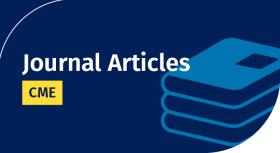
Summary for Clinicians: Clinical Practice Guideline on Pharmacologic Management of Chronic Obstructive Pulmonary Disease
Evidence-based guidelines for the pharmacological management of chronic obstructive pulmonary disease (COPD) were updated in 2020 by a multidisciplinary panel of experts. A comprehensive systematic review of the literature was performed to address the key clinical questions and critical patient-centered outcomes agreed on by the panel.
This clinical summary is intended to provide the practicing clinician with key takeaway points. These guideline recommendations focus on the pharmacological management of stable symptomatic COPD. The guideline has different implications for patients, clinicians, and policymakers. Clinicians should always consider unique individual clinical circumstances when applying these guideline recommendations to the care plan of patients with COPD.
Target Audience
Pulmonologists, critical care specialists, translational researchers, and clinicians
Learning Objectives
At the conclusion of this activity, learners should be able to:
- Describe the patient factors, symptom assessments, and laboratory studies that are needed to apply the evidence-based practice treatment guidelines in the outpatient care of their patients with COPD
- Differentiate the subpopulation of patients with COPD who would most likely benefit from the addition of an inhaled corticosteroid
- Discuss the relative benefits of palliative treatment for refractory dyspnea in COPD patients
Accreditation Statement
The American Thoracic Society is accredited by the Accreditation Council for Continuing Medical Education to provide continuing medical education for physicians.
Disclosure Statement
Article Authorship Disclosures (as submitted to the ATS prior to article publication date)
Eric J. Gartman, M.D. (Brown University Warren Alpert Medical School, Providence, RI, USA) reported no relevant financial relationships.
Sunita S. Mulpuru, M.D. (The Ottawa Hospital, Ottawa, Ontario, Canada) reported no relevant financial relationships.
Manoj J. Mammen, M.D., M.S. (University at Buffalo, Buffalo, NY, USA) reported no relevant financial relationships.
Paul E. Alexander, Ph.D. (McMaster University, Hamilton, Ontario, Canada) reported no relevant financial relationships.
Linda Nici, M.D. (Providence VA Medical Center, Providence, RI, USA) reported no relevant financial relationships.
Shawn D. Aaron, M.D. (Ottawa Hospital Research Institute, Ottawa, Ontario, Canada) reported no relevant financial relationships.
Joseph K. Ruminjo, M.D. (American Thoracic Society, New York, NY, USA) reported no relevant financial relationships.
Carey C. Thomson, M.D., M.P.H. (Mt. Auburn Hospital, Cambridge, MA, USA) reported no relevant financial relationships.
Off-Label Usage Disclosure
None
Disclosures of AnnalsATS CME Planners
The Annals of the American Thoracic Society (AnnalsATS) original research, commentaries, reviews, and educational content of interest to clinicians and clinical investigators in pediatric and adult pulmonary and sleep medicine and medical critical care. The scope of the journal encompasses content that is applicable to clinical practice, the formative and continuing education of clinical specialists, and the advancement of public health.
The publication of articles that meet these goals by itself is only one step in a multi-step process for the translation of evidence-based improvements in are to clinical practice. Testing for CME credit is designed to function as a next step in the process. This is accomplished through a series of questions written by the author(s) to test that readers have the tools needed to translate recommendations for diagnostic and therapeutic clinical care into clinical practice. Members of the AnnalsATS editorial board review these questions and edit these questions for clarity, educational content, and the quality of the evidence supporting the response to the question.
AnnalsATS CME Planners
Alan M. Fein, M.D.
Podcast Editor, AnnalsATS
Dr. Fein reported that he has no financial relationships with ineligible companies.
Constantine Manthous, M.D.
Associate Editor, AnnalsATS
Dr. Manthous reported that he has no financial relationships with ineligible companies.
Gregory A. Schmidt, M.D.
Editorial Board, AnnalsATS
Dr. Schmidt reported payments for writing a textbook on critical care medicine (McGraw-Hill) and for writing contributions for UptoDate.
Instructions to Receive Credit
To receive credit for this journal article:
- Read the journal article. Keep track of how long it takes you to read it.
- Once you open the article, the Post-Test becomes available. After reading the article, answer the post-test questions. You must answer all questions correctly to earn credit. You may take the test as many times as you like.
- Once you pass the Post-Test, the Evaluation becomes available. Answer all the evaluation questions.
- Once you complete the evaluation, select the amount of credit to receive based on the time it took you to read the article.
- You can view, save and print your Certificate by pressing the Certificate button.
- To review the credits you've earned in this system and reprint certificates, go to the My Learning drop-down list. Then select Transcript.
Available Credit
- 1.00 AMA PRA Category 1 Credit(s)™The American Thoracic Society designates this for a maximum of 1.00 AMA PRA Category 1 Credit(s)™. Physicians should claim only the credit commensurate with the extent of their participation in the activity.
- 1.00 Participation

 Facebook
Facebook X
X LinkedIn
LinkedIn Forward
Forward